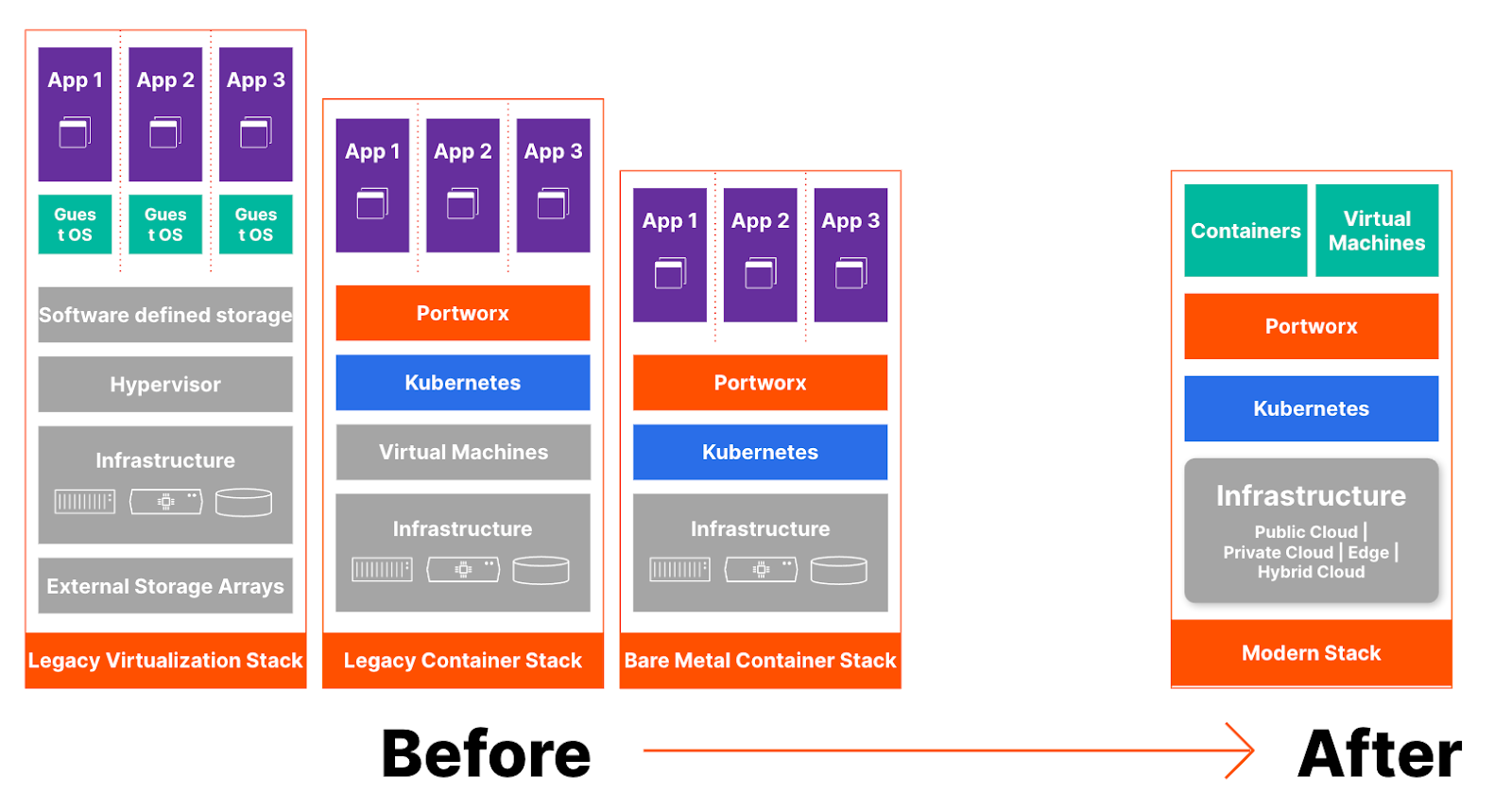Portworx Guided Hands On-Labs. Register Now
The past few years have seen a rapid increase in the adoption of containers and Kubernetes as the app development platform of the future. In fact, according to Gartner, 1 in 3 enterprise applications will run in containers by 2029. But what about the remaining enterprise applications? What about VM-based applications?
Two major trends have emerged over the past 12 months that have caused enterprises to consider the benefits and drawbacks of moving from a traditional virtualization stack to a modern virtualization architecture.
- Release of KubeVirt 1.0: The release of KubeVirt 1.0 in June 2023 has provided a technology pathway that enables running Virtual Machines on Kubernetes. This approach opens the door for enterprises to consolidate to a single app development platform and run and operate Virtual Machines and Containers side by side from a single application platform. With the backing of Red Hat, the market now has an enterprise-grade KubeVirt-based offering, Red Hat OpenShift Virtualization (OSV), that brings modern app development to the virtualization world with enterprise like Goldman Sachs fully embracing the potential of running VMs on Kubernetes at enterprise scale.
- Broadcom acquisition of VMware: Broadcom’s acquisition of VMware has created a level of uncertainty in the market and across enterprises as they look to make long-term platform decisions. With changes in the licensing and operating model, enterprises are looking for flexibility in their virtualization approach to mitigate the uncertainty, risk, and cost pressure being felt in the C-Suite. In fact, according to Gartner “through 2028 disruption in the server virtualization market will result in more than 60% of enterprises accelerating their public cloud migrations and exploring revirtualization of virtual workloads” while Forrester predicts that in 2024, “Twenty percent of VMware enterprise customers will escape the VMware stack.”
Portworx Perspective
As we talk to customers across the globe, there are three key challenges we hear as they navigate their application modernization journey:
- Cost Pressures: Customers are facing cost pressure across their application development stack. The shift from perpetual license to subscription models, as seen with some providers, coupled with price hikes, has led to an overnight spike in annual operating costs for development platforms.
- Platform Risk: Industry consolidation coupled with the pending ‘end of life’ for existing technologies like Red Hat Virtualization (RHEV) has introduced significant platform risk and uncertainty for the C-Suite. With major platform investments happening many years in advance, leaders today are looking for technology options that provide flexibility and certainty to reduce long-term risk.
- Operational Overhead: Running and supporting two different application development platforms introduces a significant amount of operational risk, toil, and technical debt. This has led many IT executives to begin looking for options that deliver consistency across their entire application development stack, with nearly 86% of respondents to a recent report citing their desire to unify containers and VMs workloads on a single infrastructure platform.
Enter Portworx by Pure Storage
Portworx is uniquely positioned to serve as a key technology platform for enterprises as they embark on their application modernization journey. With Portworx, customers benefit from a single storage and data management platform that can support both VMs and containers running on any Kubernetes platform. This enables customers to realize the benefits of Kubernetes without having to containerize their long-standing VM-based applications. Instead Portworx offers customers a migration pathway to modern application development by leveraging KubeVirt, while maintaining many of the key storage features VMware admins have come to expect – including, but not limited to, live migration, synchronous DR, and VM backup and restore.

Customer Example
The embrace of KubeVirt in the enterprise is no longer just a discussion for boardrooms and architecture diagrams, instead it has become the reality for many customers. Just last month, a major media company faced many of the challenges outlined in this blog – cost pressure on their existing virtualization infrastructure, EOL for their RHEV infrastructure, and uncertainty about their future application development platform. By leveraging Portworx and Red Hat OpenShift, this customer was able to not only gain an immediate pathway for migrating their traditional virtualization and RHEV applications, but they also now have an application development platform that is future-proofed to support both the VM-based applications of today and the containerized applications of tomorrow.
To find out more about how Portworx can help customers looking for modern virtualization alternatives, visit us at Red Hat Summit booth 104 this May, or read more about the technical details of the Portworx approach to Modern Virtualization.
Share
Subscribe for Updates
About Us
Portworx is the leader in cloud native storage for containers.
Thanks for subscribing!








